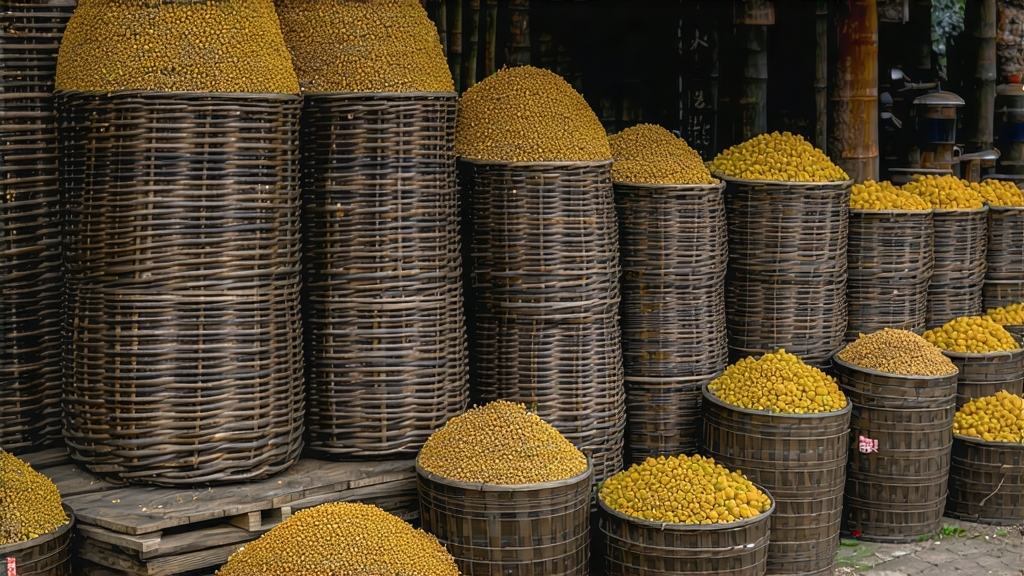
Hidden halfway up the mist-veiled slopes of the Dabie Mountains in western Anhui province, a tiny bamboo-shaded grove produces one of China’s most discreet aristocrats of taste: Huoshan Huangya, the “Yellow Bud of Huoshan.” Unlike the fame-hungry Dragon Well or the rock-solid Wuyi oolongs, Huangya has spent centuries in quiet confidence, served only at imperial tables, whispered about in Tang-dynasty poems, and tucked into the luggage of Ming-era scholars who believed the bud could “clear the palace of smoke and the mind of dust.” Today it remains the least exported of China’s six tea families, yet for those who meet it, the encounter is unforgettable—an aroma of warm chestnut and fresh orchid, a liquor the color of late-afternoon sunlight, and a finish that lingers like a soft bell in mountain air.
A STORY WRITTEN IN GOLDEN ARCHIVES
The first written record appears in the Shennong Bencaojing of the Han era, but concrete tribute status was granted during the Tang (618-907) when Emperor Taizong decreed that “the bud that turns golden three days after picking shall enter the palace only.” By the Ming, the county annals of Huoshan speak of 340 mu (about 23 hectares) of state-protected gardens, pickers wearing white gloves, and night caravans racing to Nanjing before the gates closed. When the Qing replaced the Ming, Manchu nobles added a Manchurian twist: they smoked the finished leaves above larch charcoal for three minutes to “tame the mountain spirit,” accidentally deepening the yellow patina. The 20th century brought wars and neglect; the groves were converted to sweet potato fields. It was not until 1972 that a retired soldier named Zhao Qifa replanted 300 ancient mother trees from a single surviving rootstock, restarting the lineage now protected under China’s Geographic Indication law.
TERROIR THAT PAINTS IN MONOCHROME GREEN
Huoshan county sits at 31°N, 800–1,200 m above sea level. The Dabie range traps humid clouds from the Yangtze floodplain, creating 85 % relative humidity and a temperature swing of 10 °C between day and night. The soil is Phyllitic shale rich in selenium and zinc; bamboo, ginkgo and wild orchid share the canopy, exuding terpenes that settle on tea buds like invisible perfume. Only three micro-valleys—Jinji Mountain, Foziling Reservoir, and Sunjiawan—are deemed authentic; everywhere else the same cultivar produces a greener, less honeyed leaf.
CULTIVARS: THE BUD CHOIR
The traditional plant is the local Huoshan small-leaf population called “jiuye zao” (nine-leaf early) because the ninth leaf on a shoot matures at the same moment the apex bud is ready, allowing an extremely short picking window. In the 1990s researchers released a clonal variety “Huangya 1” with higher amino acids, but purists still prefer the seed-grown mixed population whose genetic noise adds aromatic complexity. Either way, only the unopened bud with one just-unfurling leaf is taken, 2.0–2.5 cm in length, 2000 buds to yield 100 g of finished tea.
THE LOST ART OF MENHUANG
Yellow tea’s defining craft is “menhuang” (sealed yellowing), a micro-fermentation that sits conceptually between green killing-green and white withering. In Huoshan it is performed twice, each round a 24-hour meditation on moisture and breath.
- Killing-green at 140 °C on a bamboo-lined wok lasts 180 seconds—just long enough to silence oxidative enzymes while keeping 8 % residual moisture.
- Initial rolling under 6 kg pressure for 8 minutes breaks cell walls without squeezing sap; the twisted bud resembles a miniature fishhook.
- First menhuang: the leaves are piled 8 cm deep in cedar boxes lined with wet linen; temperature is held at 28 °C, RH 75 %. For 18 hours the pile is turned every 90 minutes; chlorophyll degrades to pheophytin, catechins dimerize, and a soft corn-silk aroma appears.
- Low-temperature drying at 60 °C reduces moisture to 12 %, then the leaves